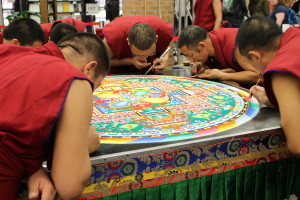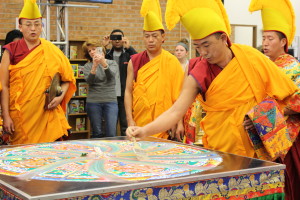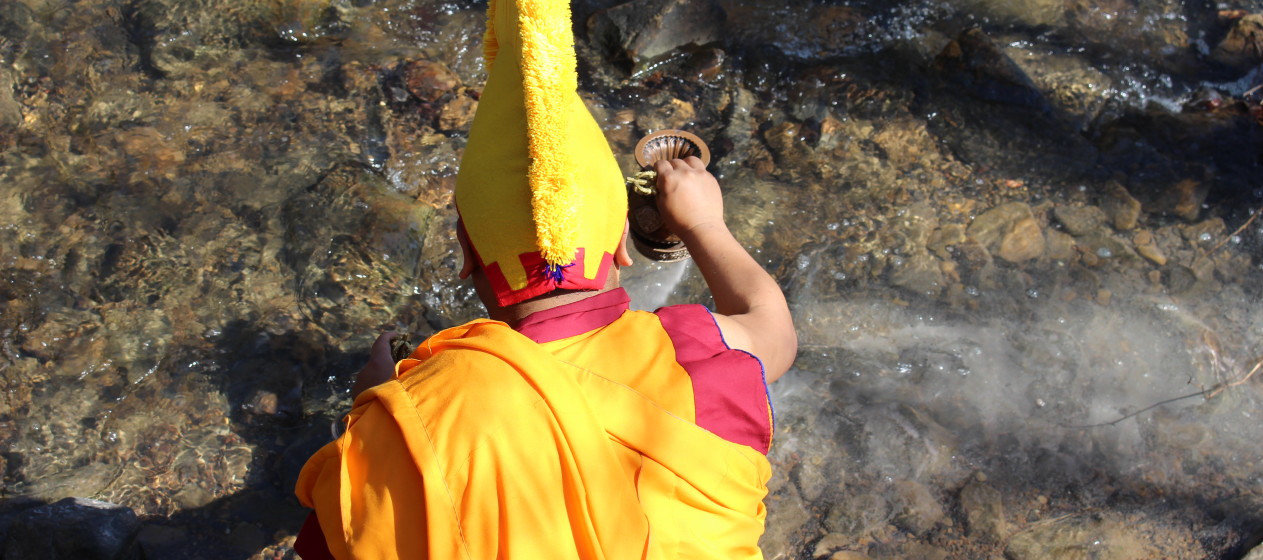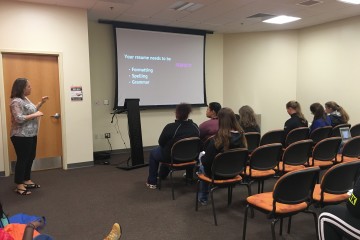Week Long Mandala Creation Comes to a Close
The mandala sand painting was finally completed by the Tibetan monks of Drepung Loseling Monastery on Thursday, March 9, at noon when the Mandala Closing Ceremony began in the J. Lewis Ort Library on Frostburg State University’s campus. The lamas began the mandala creation on Sunday, March 5, and they worked rigorously in silence to create this temporary piece of art until the closing ceremony.
The artists are monks from the Drepung Loseling Monestary, which has been re-established in exile in South India. The performers are a part of The Mystical Arts of Tibet world tour. The tour is endorsed by His Holiness the Dalai Lama to promote world peace and healing by sharing Tibet’s rich and authentic sacred performing and visual arts with modern audiences. The lamas began their first tour in 1988 and have enjoyed an overwhelming reception across North America, South America, and Europe. At the end of each tour the monks return to Drepung Loseling Monastery to continue their vocation.

Over a hundred spectators filled the library to witness the closing ceremony. People were standing shoulder to shoulder to get a glimpse of the completed mandala before it was swept away. The event drew in students, faculty, elementary school children, and the Frostburg community. Some spectators were visiting the mandala for the first time while others have been visiting the library to watch the mesmerizing process throughout the week.
FSU student and mass communication major Eddie Adams was one of the many observers packed into the library before the ceremony began. Adams described the event as, “very interesting and enjoyable experience.” He added that he was in awe of all the people who came to the event. Bill Mandicott, Assistant Vice President of Student and Community involvement, was also in attendance. “This is the best attended event I’ve seen in a while…I’ve never seen this outcome of people,” commented Mandicott. He also described the event as a, “tremendous opportunity.” Professor Anni Danzi told The Bottom Line, “I think this event is great for Frostburg because it showcases something very different culture than what we have here. It’s great for people to be exposed to new things. It’s an excellent cultural experience.”
Souvenirs were being sold throughout the week and during the closing ceremony. Merchandise included t-shirts, mala beads, wall hangings, jewelry, incense, books, purses, singing bowls, Bell and Dorjes, and Timsha Bells. All proceeds from the event support over 3,000 monks at the Drepung Loseling Monastery and help preserve the endangered Tibetan community living in exile.

To begin the ceremony, Geshe Lobsang Tenzin Negi spoke on behalf of the other lamas to thank FSU and to explain the closing ceremony process. Geshe Lobsang Tenzin Negi is the monks’ spiritual director who was chosen at age 14 to study at the Institute of Buddhist Dilects, the private school of His Holiness the Dalai Lama. Before the ceremony started, the lamas gave Dr.Tom Bowling, Mary Jane Plumber, Melanie Moore, and Lea Messman-Mandicott scarves and mandala photos as a thank-you.
The monks performed their multiphonic changing, known as zokkay (complete chord). As they chanted, one monk swept away every grain of sand that was painstakingly placed over the five days. Traditionally most sand mandalas are deconstructed shortly after completion. This is done as a metaphor of the impermanence of life. Once the sand was completely swept up and the mandala was no more, the sand was split into two piles. One pile was placed in an urn for the final part of the ceremony and the other pile was put into small bags and distributed to the crowd. The distribution of sand to the spectators was to fulfill the function of healing. The crowd was given the choice to keep the sand or to use it during the final part of the ceremony.

The lamas, while chanting and carrying the remainder of the sand in the urn, led a large assembly of spectators down to the Sand Spring Run which flows through the Arboretum on campus. Traditionally, the sand is carried to a nearby body of flowing water, where it is deposited. The lamas ceremoniously placed the sand in Sand Spring Run thus, concluding the ceremony. The flowing body of water then carried the healing blessing of the mandala to the ocean. From there it would spread throughout the world by for planetary healing.




